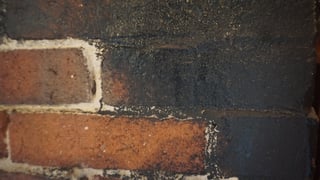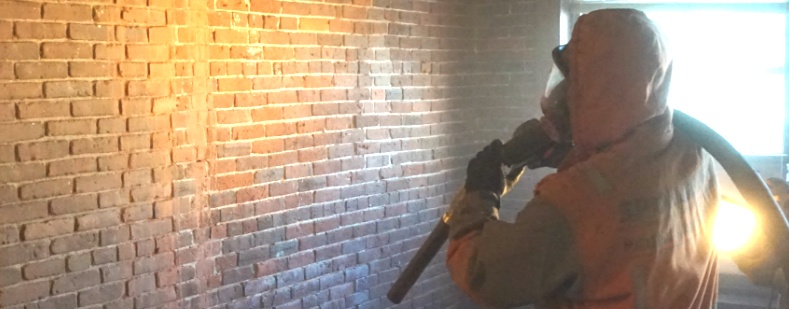Brick has been used for the construction of homes and buildings since ancient times. The first known brick was discovered on an archeology site in the Middle East, dating its use back to 7500BC. This discovery means humans started using brick 3,000 years before the invention of the wheel! Similar to the wheel, the materials used to make brick has evolved.
Even today, brick is different from region to region. The same general concept remains: sand and other masonry components are combined with water and are put into a mold or are extruded into a brick-like shape. These bricks are then dried, either by sun or by kiln. Once hardened, the new brick is used for projects ranging from homes and buildings to bridges, roads, and walkways. In many cases this brick will be painted or coated to protect it from the weather, environmental staining, or even graffiti.
Below are the two leading methods for removing paint from brick:
Using Abrasive Blasting to Remove Paint from Brick
Abrasive blasting is the quickest way to restore brick. Using air pressure and abrasive media, the top layers of brick (and whatever has been used to coat them) are removed, revealing a clean layer of brick  underneath. Abrasive blasting can be used to remove paint, sealant, excess mortar, efflorescence, or any surface contaminants that may be visible or invisible.
underneath. Abrasive blasting can be used to remove paint, sealant, excess mortar, efflorescence, or any surface contaminants that may be visible or invisible.
For the successful use of abrasive blasting on brick, blasters should not dwell in any one section, moving the blast nozzle at a shallow angle while working. This leads to a consistent blast throughout a brick restoration project.
Sponge Media™ micro-abrasives are frequently used on brick restoration projects because of its physically pliant characteristics. These unique properties allow for less masonry micro-fractures, which is a common concern for regular abrasives. These same properties that help reduce the risk of microfracture also contain 99% of dust at the source of generation. Both brick and mortar can be blasted to a clean, restored finish. Sponge Media is highly recyclable, meaning abrasives can be used a number of times. This allows for less material handling and less media needed on a jobsite. When less media is used, less media needs to be disposed of, which contributes to lower overall project costs, especially when removing lead paint from brick.
Using Strippers to Remove Paint from Brick
Another method for removing paint from brick is chemical stripping. Chemical strippers are usually applied wet and they bond to the paint during the curing process. After curing, strippers are peeled off, taking old paint with it. In some cases, strippers must be reapplied several times to remove all paint layers. Note that changes in temperature can lower the effectiveness of strippers. After removal, a washing treatment is sometimes required to return the substrate to its original pH level – especially before the application of a new coating.
Some may confuse strippers with thinners. A paint thinner will remove paint in layers, working from the top-coat down to bare brick. Thinners vary in effectiveness. Different strengths of thinner may be needed for different kinds of paint. Brick that has been painted in multiple coats may present challenges to those using chemical methods to restore brick. Workers may find that chemicals remove paint from one part of the brick but not the other.
Strippers and thinners can sometimes cause more harm, as the chemicals in the stripper can leach into soft, porous brick. Runoff from strippers can kill vegetation and enter ground water if not properly trapped. Applicators of both thinners and strippers should be extremely cautious of fumes produced by these chemical methods.
Silicosis from Brick Restoration.
A word of caution on the restoration of brick - many brick types contain silica sand as a component. If silica becomes airborne and is inhaled by workers or those around them, it can lead to serious health complications. Silicosis is a potentially deadly disease that can ravage the respiratory system from prolonged exposure.
Silicosis is easily avoided through the use of proper abrasive blasting PPE.








